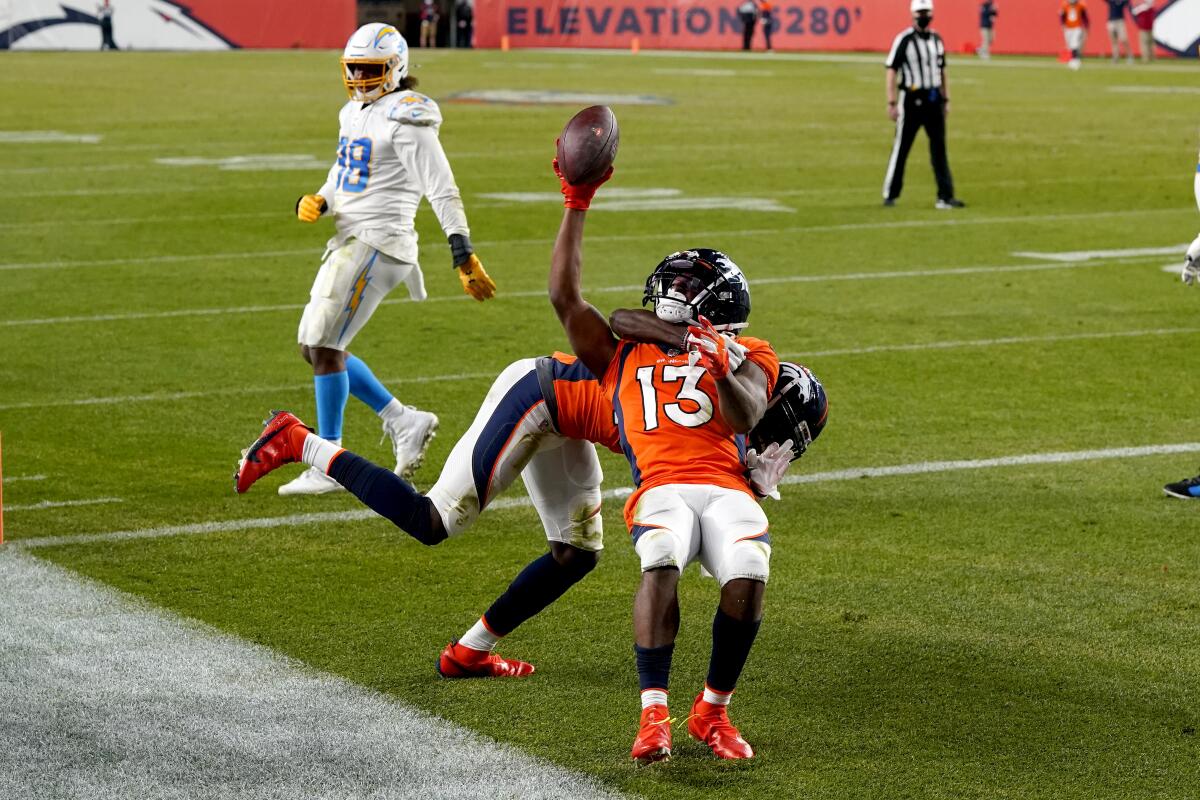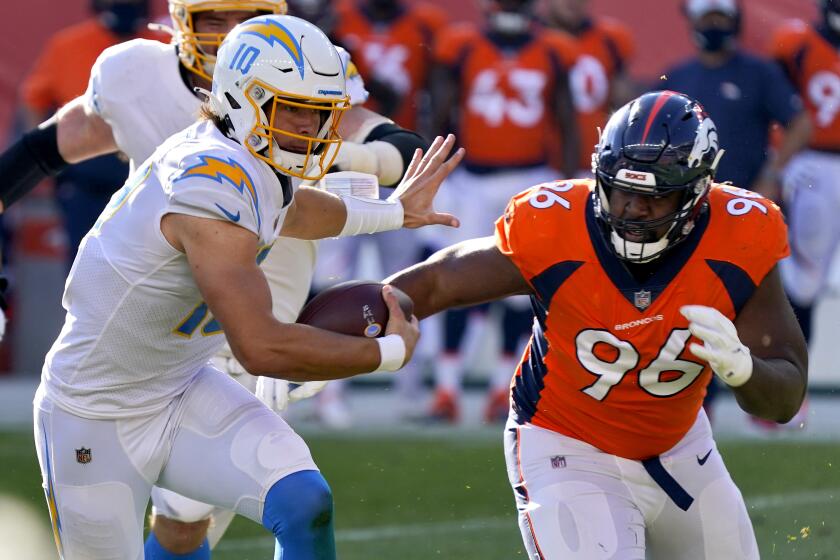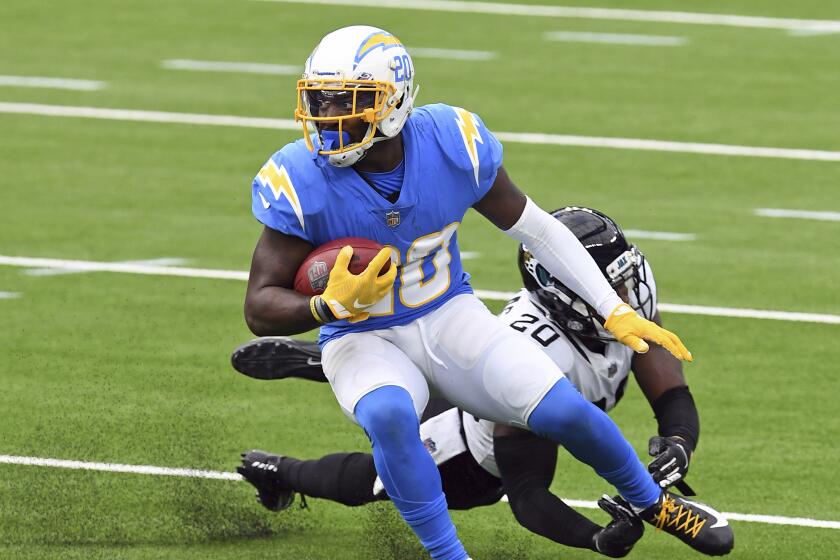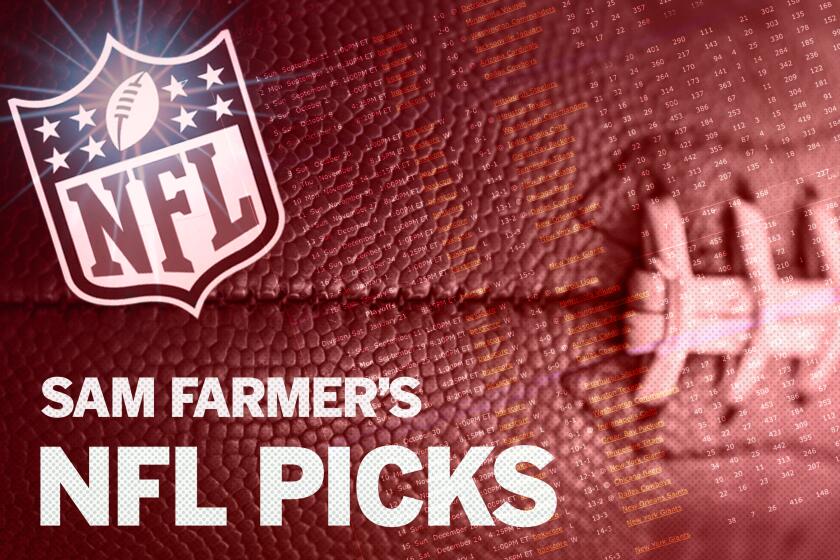Chargers look to correct defensive lapses in preparing for Raiders

- Share via
A frustrated Drue Tranquill took to Twitter on Sunday night to express his disappointment.
Watching the Chargers lose 31-30 to the Denver Broncos by relinquishing a double-digit lead for the fourth time this season, the injured linebacker posted a widely used quote to his 21,000 followers:
“Insanity is doing the same thing over and over again and expecting different results.”
His teammates and coaches agree. After playing solid defense for much of their games, the Chargers have repeatedly collapsed, allowing opposing offenses to mount comebacks in the second half. Now, the players and staff are dissecting the problem.
“As a whole, each player needs to hold a little bit more accountability and go out there and make these plays,” said cornerback Casey Hayward.
A Times review of film found that opposing offenses regularly attack the Chargers’ zone defensive secondary, gashing them for yards in the middle of the field or along the sideline en route to winning games.
Justin Herbert put in another encouraging performance for the Chargers on Sunday against the Broncos, but the team still lost.
The Chargers’ continued use of four-man rushes, which is considered the team’s strength, fizzles late in games, allowing quarterbacks time to find open receivers in the zones’ soft spots.
Against the Broncos, New Orleans Saints and Tampa Bay Buccaneers — in games Los Angeles lost after leading by 17 points or more — the Chargers rushed more than four players on approximately 9% of pass plays when they were in the lead, according to film review.
During those sequences, the Chargers produced only three sacks. Hayward thinks the secondary can correct the coverages if they clean up their execution.
“Everybody every week is trying to beat us the same way, and we know that,” Hayward said. “We just have to try and be on our stuff.”
The Chargers have attributed their late-game meltdowns to mistakes such as blown assignments and missed tackles. After the 38-31 loss to the Buccaneers, defensive coordinator Gus Bradley bluntly assessed his unit’s capabilities if they don’t play soundly.
“When we’re not very precise, if we’re not on it, we can become very, very average,” he said.
Teams have capitalized on the schematic choices as well as those lapses.
For nearly two quarters, the Chargers held quarterback Drew Brees to 43 passing yards and forced an interception, and the Saints trailed 20-3 after the two-minute warning. But then, Brees orchestrated a surgical drive, completing five consecutive passes under the Chargers’ zone coverage for 50 yards, setting the Saints up at the 1-yard line.
He then scored on a quarterback sneak, igniting their come-from-behind victory. The Chargers rushed four on every play that sequence.
Halfway through the fourth quarter on Sunday, Denver quarterback Drew Lock faced a four-man rush, then found receiver DaeSean Hamilton on a post route in the middle of the field. Hamilton was open in the zone behind the linebackers and in front of the safeties. One of them slipped, and Hamilton raced to the end zone for a 40-yard touchdown, cutting Denver’s deficit to 27-24.
On the game’s final drive, Lock connected with running backs Melvin Gordon and Phillip Lindsay on three consecutive short passes near the right sideline underneath the Chargers’ zone, including a pitch-and-catch with Gordon that converted a first down.
Five plays later, the Broncos scored a touchdown and won the game 31-30 on a walk-off extra point. Coach Anthony Lynn said that performance might be the most discouraging, especially after limiting the Broncos to 60 total yards before halftime.
“That team did not do anything different in the first half than in the second half,” Lynn said. “That’s what makes that so frustrating. In the first half, you look like the 1985 Bears. In the second half, you give up 27 points.”
The Chargers boast one of the most feared pass-rushing duos in the league in defensive ends Joey Bosa and Melvin Ingram. Bosa has been fighting through nagging injuries and was being evaluated for a concussion during the final drive against the Broncos. He remains in the concussion protocol. Ingram missed three games, including against the Buccaneers and the Saints, because of a knee injury.
The Chargers dealt defensive back Desmond King to Tennessee on Monday, one day before the NFL trade deadline. They received a sixth-round pick in 2021.
Las Vegas Raiders coach Jon Gruden said those injuries, along with the absence of safety Derwin James, might have contributed to the Chargers’ struggles. He said Bradley’s scheme is “proven to go a long way in the playoffs” because Los Angeles used it in 2018 when they reached the AFC divisional round. Ahead of their matchup next Sunday, Gruden said he won’t overlook them.
“They have an outstanding pass rush when everybody’s available,” Gruden said. “They’re still capable of making big plays and collapsing the pocket and getting after your quarterback.”
Lynn said things may “speed up” for younger players late in games, causing miscommunications. He’s confident the team can correct their shortcomings, but suggested he and the staff could “dial back” on some of the more intricate concepts in the defense.
“There’s not a whole lot to change, but these guys do a heck of a job of getting these young men ready to be in these positions where they’re playing good ball,” Lynn said. “But to finish games like this, we have to communicate better.”
More to Read
Go beyond the scoreboard
Get the latest on L.A.'s teams in the daily Sports Report newsletter.
You may occasionally receive promotional content from the Los Angeles Times.









